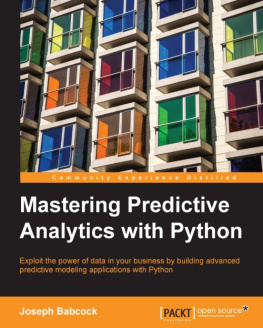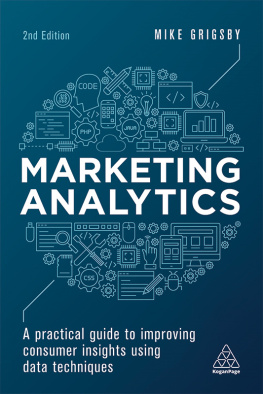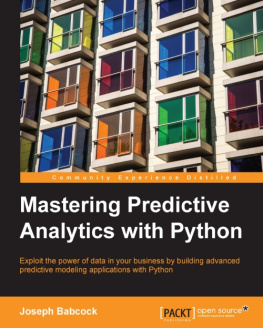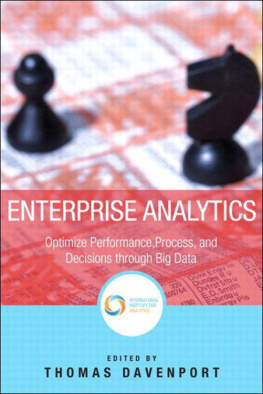Thomas W. Miller [Thomas W. Miller] - Marketing Data Science: Modeling Techniques in Predictive Analytics with R and Python
Here you can read online Thomas W. Miller [Thomas W. Miller] - Marketing Data Science: Modeling Techniques in Predictive Analytics with R and Python full text of the book (entire story) in english for free. Download pdf and epub, get meaning, cover and reviews about this ebook. year: 2015, publisher: PH Professional Business, genre: Home and family. Description of the work, (preface) as well as reviews are available. Best literature library LitArk.com created for fans of good reading and offers a wide selection of genres:
Romance novel
Science fiction
Adventure
Detective
Science
History
Home and family
Prose
Art
Politics
Computer
Non-fiction
Religion
Business
Children
Humor
Choose a favorite category and find really read worthwhile books. Enjoy immersion in the world of imagination, feel the emotions of the characters or learn something new for yourself, make an fascinating discovery.
- Book:Marketing Data Science: Modeling Techniques in Predictive Analytics with R and Python
- Author:
- Publisher:PH Professional Business
- Genre:
- Year:2015
- Rating:3 / 5
- Favourites:Add to favourites
- Your mark:
Marketing Data Science: Modeling Techniques in Predictive Analytics with R and Python: summary, description and annotation
We offer to read an annotation, description, summary or preface (depends on what the author of the book "Marketing Data Science: Modeling Techniques in Predictive Analytics with R and Python" wrote himself). If you haven't found the necessary information about the book — write in the comments, we will try to find it.
Now, a leader of NorthwesternUniversitys prestigious analytics program presents afully-integrated treatment of both the business and academicelements of marketing applications in predictive analytics. Writingfor both managers and students, Thomas W. Miller explains essentialconcepts, principles, and theory in the context of real-worldapplications.
Building on Millers pioneering program,Marketing Data Science thoroughly addressessegmentation, target marketing, brand and product positioning, newproduct development, choice modeling, recommender systems, pricingresearch, retail site selection, demand estimation, salesforecasting, customer retention, and lifetime value analysis.
Starting where Millers widely-praisedModeling Techniques in Predictive Analytics left off, heintegrates crucial information and insights that were previouslysegregated in texts on web analytics, network science, informationtechnology, and programming. Coverage includes:
The role of analytics in deliveringeffective messages on the web
Understanding the web by understanding itshidden structures
Being recognized on the web andwatching your own competitors
Visualizing networks and understandingcommunities within them
Measuring sentiment and makingrecommendations
Leveraging key data science methods:databases/data preparation, classical/Bayesian statistics,regression/classification, machine learning, and textanalytics
Six complete case studies addressexceptionally relevant issues such as: separating legitimate emailfrom spam; identifying legally-relevant information for lawsuitdiscovery; gleaning insights from anonymous web surfing data, andmore. This texts extensive set of web and network problems draw onrich public-domain data sources; many are accompanied by solutionsin Python and/or R.
Marketing Data Science will be an invaluable resourcefor all students, faculty, and professional marketers who want touse business analytics to improve marketing performance.
Thomas W. Miller [Thomas W. Miller]: author's other books
Who wrote Marketing Data Science: Modeling Techniques in Predictive Analytics with R and Python? Find out the surname, the name of the author of the book and a list of all author's works by series.

![Thomas W. Miller [Thomas W. Miller] Marketing Data Science: Modeling Techniques in Predictive Analytics with R and Python](/uploads/posts/book/119596/thumbs/thomas-w-miller-thomas-w-miller-marketing.jpg)




![Thomas W. Miller [Thomas W. Miller] - Modeling Techniques in Predictive Analytics with Python and R: A Guide to Data Science](/uploads/posts/book/119642/thumbs/thomas-w-miller-thomas-w-miller-modeling.jpg)
![Thomas W. Miller [Thomas W. Miller] - Web and Network Data Science: Modeling Techniques in Predictive Analytics](/uploads/posts/book/119619/thumbs/thomas-w-miller-thomas-w-miller-web-and.jpg)
![Thomas W. Miller [Thomas W. Miller] - Sports Analytics and Data Science: Winning the Game with Methods and Models](/uploads/posts/book/119598/thumbs/thomas-w-miller-thomas-w-miller-sports.jpg)




 Information search. We begin by learning what others have done before, learning from the literature. We draw on the work of academics and practitioners in many fields of study, contributors to predictive analytics and data science.
Information search. We begin by learning what others have done before, learning from the literature. We draw on the work of academics and practitioners in many fields of study, contributors to predictive analytics and data science.